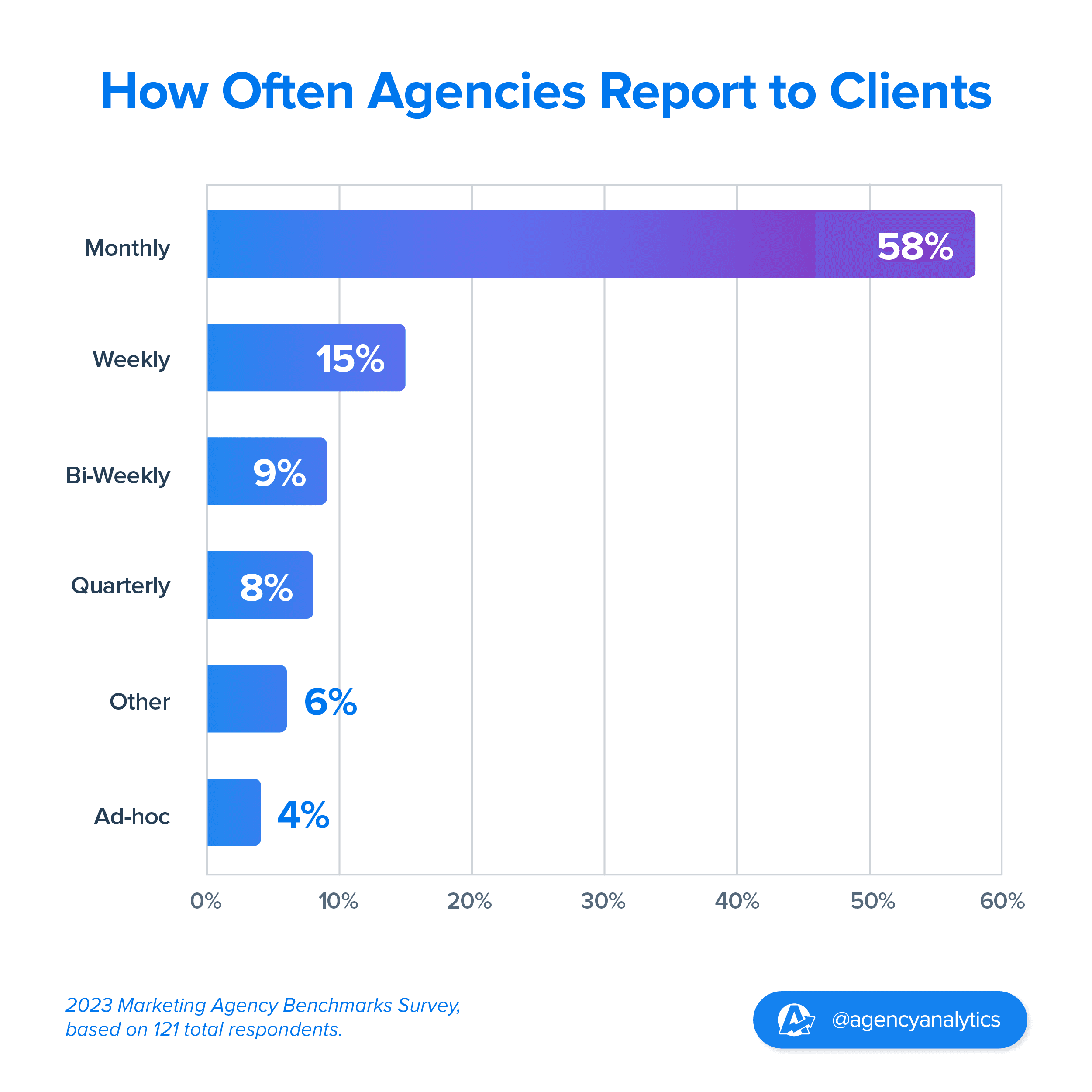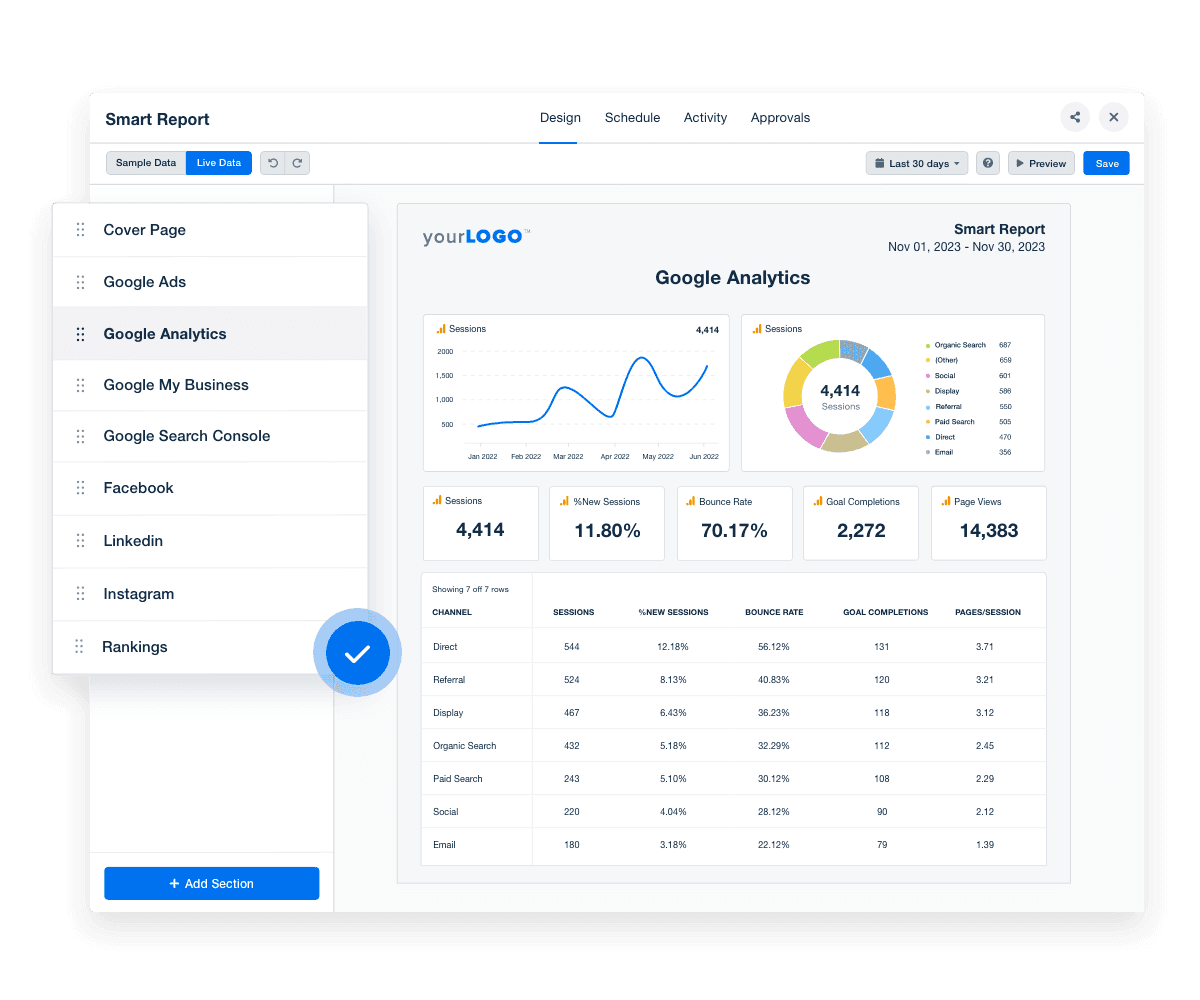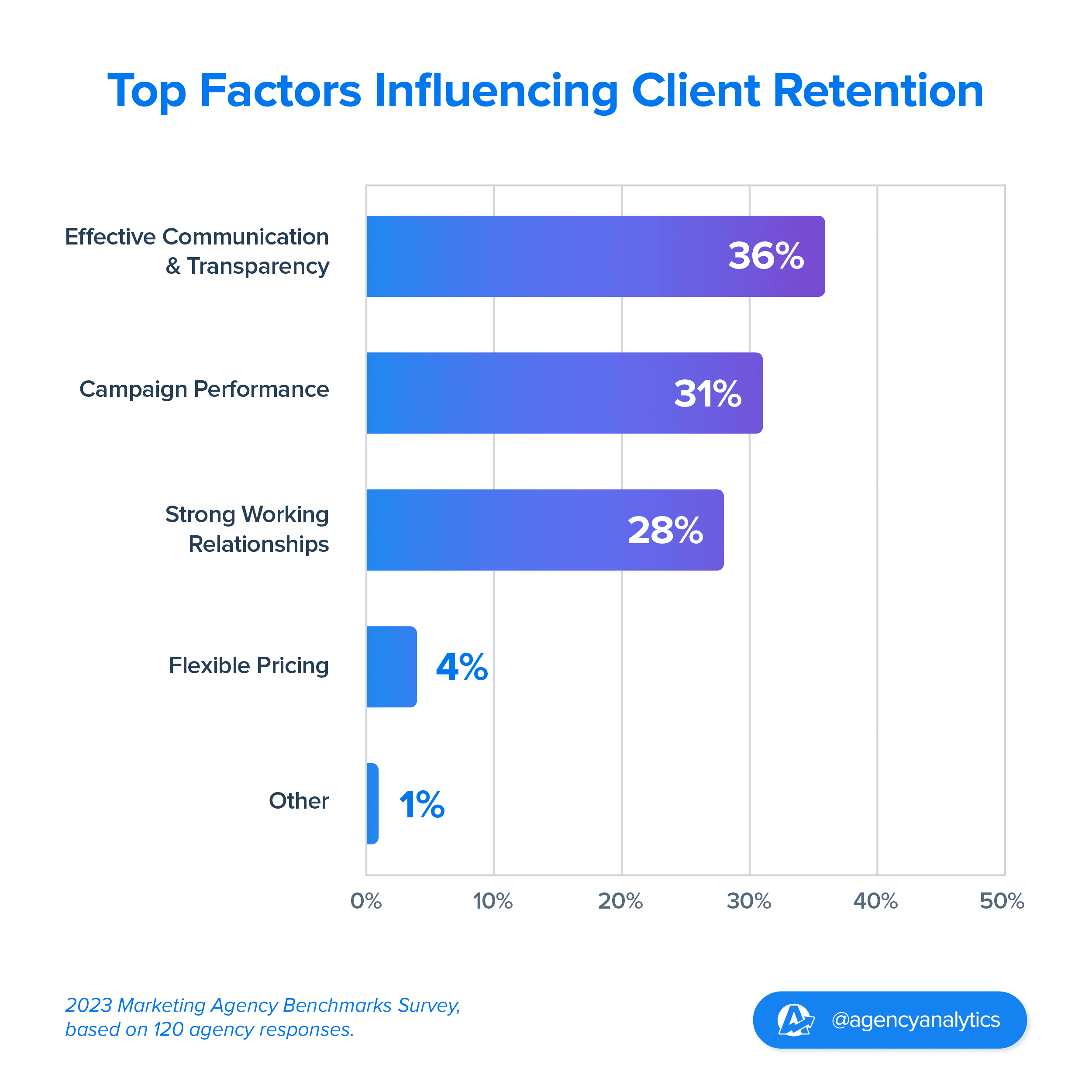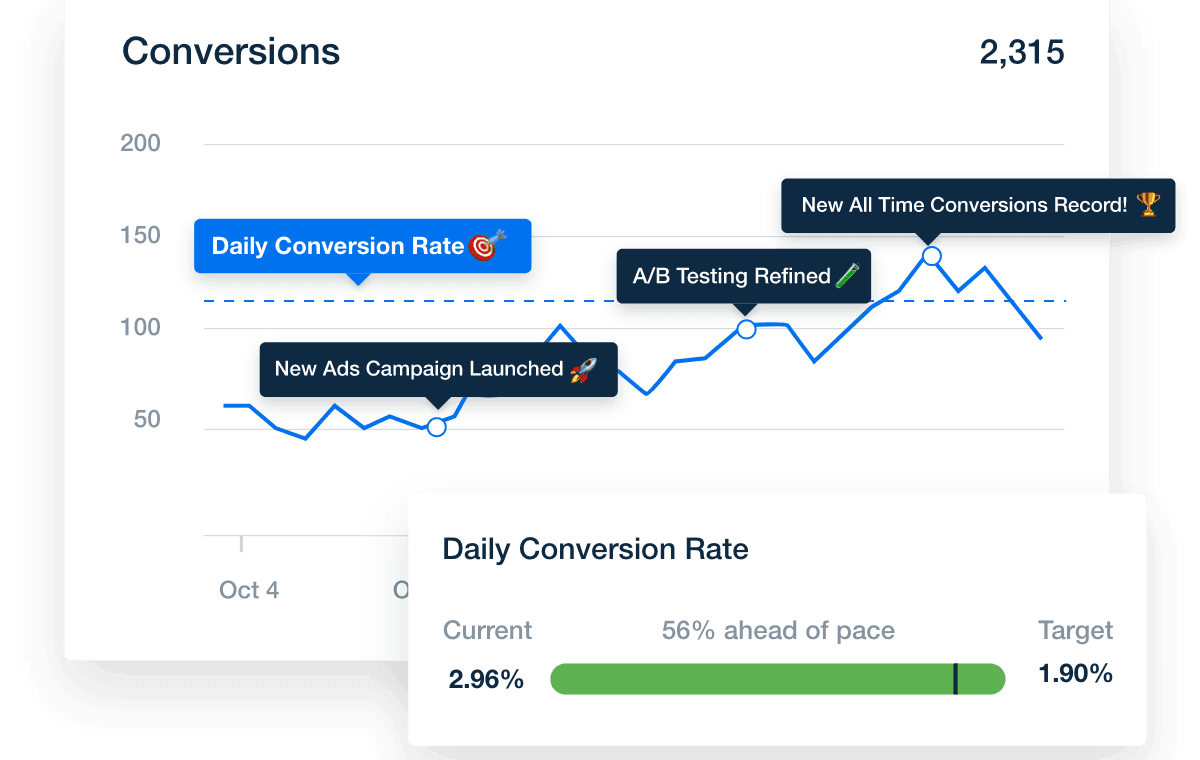Table of Contents
Quick Summary:
Transform your client reporting meetings into meaningful moments that build trust and drive results. This article guides you through the key steps and best practices for effective reporting meetings, from setting a clear agenda to using storytelling and visuals. Learn how to run more impactful reporting meetings that go beyond the numbers.
Keeping clients updated on the results of your agency's work helps build trust and transparency, and opens important conversations. Regular reporting meetings are a chance to share wins, investigate performance issues, and explore ways to optimize, improve upon, or launch new initiatives.
Given that AgencyAnalytics is a reporting solution purpose-built for marketing agencies, we naturally have an in-depth understanding of how to truly maximize the benefits of reporting meetings. Over the years, we've spent a lot of time speaking with our community of 7,000+ agencies, asking them about how they make the most of their face time with clients.
In this article, we’ll be sharing our top tips for running effective meetings that demonstrate agency ROI and strengthen client relationships, based on insights gathered from agencies just like yours.
Let’s get started.
Why Should Agencies Conduct Reporting Meetings?
Client reports and dashboards share data with clients to demonstrate how your agency’s strategies have resulted in tangible wins. So why is it necessary to meet in addition to simply sharing the data?
Reporting meetings serve as a health check for your client relationships. They're an opportunity to go over your team's output, show the impact of those efforts on the client's business objectives, and explore ways you might adjust for stronger results.
This helps you ensure accountability on what you'd agreed upon and manage client expectations in real-time. It's also a good way to open discussions around optimization, future plans, and next steps (i.e., upselling and cross-selling your agency's services).
Each reporting meeting is also an important moment for building and maintaining strong relationships with your clients. Having these discussions allows your agency to demonstrate that you have a clear understanding of your client's expectations, needs, and key performance indicators (KPIs). This builds trust and rapport, solidifying your agency's reputation and the value you provide for your clients.
How Often Should You Have Reporting Meetings?
You know you want to meet regularly, but how often is too often? The ideal cadence will vary depending on a few factors, like the type of work your agency is doing for the client and the goals you've set with them for the project. Generally speaking, it's better to meet more frequently than not enough, so long as you're not clogging up participants' schedules (either your client's or your team's).
Our recent Marketing Agency Benchmarks Survey found that a majority of agencies (58%) send out client reports on a monthly basis, followed by 15% that report weekly.

While you might choose to send reports more regularly, a monthly reporting meeting tends to strike the right balance for both your clients and your agency. It allows enough time to pass so you'll have fresh results to review, but isn't so long that you'll have too much to catch up on.
I've always been big about building and developing relationships–not just a ticket system that makes clients just another number in the line. We let them know, “If you have an issue, we're going to answer. We're going to come out and meet with you if you want to meet in person. We're going to meet every month. We want to be at that meeting because we want to let you know what we're doing for you, and what our goals are, and, if you have any questions or or any specific goals that you want us to work on.
Kevin Watts, President, Raincross
How To Run a Client Report Meeting: 5 Key Steps
Once you've figured out your meeting cadence and sent out a recurring calendar invite, what's next? Here are 5 key steps to ensure productive meetings, active participation, and fruitful discussions with your clients:
1. Create a Meeting Agenda
Creating a detailed meeting agenda is an essential pre-meeting preparation task that leads to more effective meetings. Arrange each agenda item so it flows from the previous one and into the next and make sure you've covered all the critical talking points. When creating your meeting agenda, keep the following tips in mind:
Set Time Blocks: Giving each agenda item a set timeframe supports better time management and more productive conversations.
Share in Advance: Sending the meeting's agenda to all meeting participants ahead of time gets everyone on the same page.
Leave Time for Discussion: Include time at the end to address client questions, circle back to any key points, or work through any strategic planning.
A clear agenda helps with managing time effectively and avoiding any unproductive or redundant conversations—helping you proactively deal with time pressure at your agency. It also makes for a more productive meeting, because all meeting participants know the key topics you're there to discuss.
Keep your agenda's and past meeting notes stored in a specific location so that you can easily refer back to an agenda from a previous meeting and carry-forward any key discussion points that were not fully addressed.
2. Gather the Data
Client reports might focus on overall results or narrow in on a certain project. It's important to be clear on the meeting goals ahead of time so that your report is comprehensive, and your insights and recommendations are relevant. As you collect data to create meeting reports, be sure to:
Revisit Goals: Go back to the original goals and KPIs you established with your clients at the start of the project, and any that may have come up since then. Use those to guide your data collection.
Select Relevant Metrics: Don't just copy and paste your last report and update the numbers. Consider whether the same metrics are all still relevant, and whether other metrics would be worth including this time.
Pull Data from Multiple Sources: Gathering data from more than one source helps paint a bigger picture of the performance of your team's work.
During client meetings, we rely on AgencyAnalytics to review key data pieces, facilitating meaningful discussions and actionable recommendations. By implementing this robust reporting solution, we have significantly reduced the time it takes to report statistics to our clients, allowing us to focus more on analysis, strategy, and driving results.
Alexa Rees, SEO Manager, seoplus+
AgencyAnalytics compiles data from more than 80 marketing platforms, allowing you to help you write effective meeting reports that paint the full picture of your agency’s contributions–without wasting precious billable time manually extracting the numbers. It acts as a backbone for agency reporting meetings, providing teams with a blueprint to follow when sharing progress and results throughout the discussion.
Further, the Smart Reports feature empowers agencies to create reports from scratch in just 11 seconds, pulling in the most popular metrics from each integration into a comprehensive, white labeled report.

Want to build customized client reports in 11 seconds flat? AgencyAnalytics puts your client reporting on autopilot, allowing your team to focus on their creative work (and stop wasting billable hours). Try it free for 14 days!
3. Compare and Contextualize Data
Beyond simply providing updated numbers, you need write meeting reports that anchor the data in your report. This is how your agency makes the data meaningful, and really shows the results of your work. Here are some ways to bring context to the data you present at reporting meetings:
Track Trends: Demonstrate how the data has changed over time and indicate interventions, milestones, or efforts your agency made that impacted that trajectory.
Compare and Contrast: Analyze the results from different channels, sources, formats, campaigns, or other differentiating factors. Show what's working well and the pros and cons of various tactics and strategies.
Benchmark: Using historical data, industry data, or competitor data, show how your client's results stack up in comparison to the set standard.
Contextual data makes for more nuanced discussions, supports stronger decision making, and informs results-oriented strategies. It's also an important way to back up any recommendations your agency makes for future improvements and optimizations.
For example, rather than simply sharing the increase in sales on a client’s Shopify store, share the entire journey to demonstrate the efficacy of your agency’s strategies. Did the Facebook Ads campaign contribute directly to a spike in ecommerce traffic? A reporting meeting presents the perfect opportunity to hammer this point home.

4. Use Storytelling and Visualization
In addition to contextualizing the data, you also want to bring it to life through storytelling and informative visuals. This helps emphasize the key details you're trying to convey and sparks livelier discussions and active participation all around. Here's how:
Create a Narrative: Develop a story around the data. Position the client as the protagonist and your agency as the trusty guide that helped them overcome their challenges and succeed in achieving their goals.
Leverage Visuals: Use graphs, charts, and infographics to display data in compelling visual formats. Strong data visualization techniques support your narrative development and amplifies storytelling.
Simplify Complex Information: Remember to pinpoint the key insights and takeaways that connect with your meeting objectives, and bring the discussion back to those points throughout the meeting.

Visualizations are a great way to draw more attention to positive outcomes and create clarity around trends. Paired with clear communication that follows a narrative, you're sure to present a compelling case for how your agency interprets the report results—and what you plan to do with them.
5. Share Dashboards and Reports
Ideally, everyone in the conference room (or on the Microsoft Teams call) will have access to the report being discussed. Sharing reports with clients helps promote participation and makes for a more effective meeting, because everyone has the same information at hand. Here are a few tips for sharing reports with clients:
Automate Reporting: Once you’ve set up your template or 11-second Smart Report and decided on a reporting cadence, automate the scheduling so that clients receive their updates on time, every time.
Share Ahead of Time: When you send the report ahead of the meeting, it supports meeting preparation from everyone. Your clients will have time to review and digest the data, and arrive with meaningful reflections, questions, and ideas.
Provide Dashboard Access: In addition to generating regular detailed reports, share real-time data dashboards with clients. This promotes transparency and allows for more regular tracking. AgencyAnalytics lets you set up customized client dashboards with granular access permissions, allowing your clients to track their performance independently, 24/7.
We have a dashboard that we review during our weekly client meetings. This allows us to visually show how various marketing efforts are working. Additionally, we set up monthly automated reports that go out to stakeholders at the start of each month, keeping our agency top of mind for the entire C-Suite.
Tim Akers, Founder, Akers Digital
Establishing access to real-time data creates continuity from one meeting to the next, and encourages reflection outside of the meeting time—promoting efficiency when you're all in the meeting room together.
Best Practices for Better Client Meetings
We've all had the experience of walking out of a meeting or logging off of a virtual call and thinking:
"Well, that could have been an email."
Meetings that feel like productivity killers are a real drag. Of course, this is the opposite of how you want clients to feel after a report meeting with your team. Ideally, they'll be walking away with a blissful sense of post-meeting clarity and inspiration.
So, how do you create a meeting experience that feels like a high return on time invested and a clear path forward for everyone? Follow these best practices to make your next report meeting more productive and inspiring for everyone:
Meet Face-To-Face (Or Use Video Conferencing)
The meeting location sets the tone. An in-person meeting creates a sense of camaraderie and collaboration, but when it's not possible, a video call is better than voice-only. Being able to see everyone not only helps keep people engaged, it also allows for nonverbal communication that supports relationship building.
Example: If you're meeting with a new client for the first time, hosting them at your agency's office adds a personal touch. It gives them a chance to peek behind the curtain at your agency's culture and operations and to meet other team members. This is super powerful for building a sense of trust.
Leave Time for Questions, Brainstorming, and Discussion
Building dedicated time for discussion into your meeting agenda not only creates space for important dialogue, but shows that your team is open to feedback and eager to get your client's input. This also helps everyone maintain focus throughout the meeting, knowing that there will be time for clarifications and decision making at the end.
Example: When you're hosting a report meeting on the initial results from a new campaign, your client will most likely have questions. They might also have feedback or suggestions from other stakeholders who aren't present, or may want to revisit allocated responsibilities and make adjustments.
Further, remember that report meetings aren’t just about patting your agency on the back (although, of course, that’s a key element). It’s important to report on all results–even the ones that are falling short of targets. Reporting meetings present an opportunity to cultivate a connection with clients based on transparency, which ultimately is the key to long-term client retention.

According to the AgencyAnalytics Marketing Agency Benchmarks Survey, the majority of agencies believe that effective communication and transparency is the main contributing factor that keeps clients coming back for more.
We want to make sure that our clients feel valued and appreciated, and that we're providing a good level of service to them. And so even when we mess up, we're transparent. We want an open line of communication all the time.
Kevin Watts, President, Raincross
Present Upsell and Cross-Sell Opportunities
Report meetings are the perfect time to present a pitch. If the results are awesome, your agency is primed to show off what more you're capable of. When results aren't so great, it's a good moment to analyze what went wrong and present a new approach that draws on those insights. Finally, when you're wrapping up on one project, it's the perfect time to make a recommendation for what's next.
Example: If your client’s PPC campaigns are performing well, but their organic traffic is lacking, you might pitch ongoing blog post development. Highlighting how some of your other clients are successfully using their blog to drive traffic and convert leads will illustrate the potential benefits, making it an easier sell.
If your agency typically runs shorter term contracts with clients, reporting meetings also present an opportunity to extend the relationship past the initial phase.
For example, when Simplified SEO’s clients reach the end of their contract, they’re offered the opportunity to sign on to a lower cost tier of service more akin to a consultancy rate. The primary benefit offered to those clients? They retain access to their AgencyAnalytics dashboard, allowing them to continue to monitor progress of the SEO strategy previously put in motion by the agency.
Take Detailed Notes
Keeping detailed meeting minutes not only helps keep everyone accountable for what's been agreed upon, it also makes for better follow up discussions in future meetings.
Whether you implement a meeting note software or simply designate someone to take meeting notes, make sure to meticulously document all decisions and follow up actions. This way you'll have an official record to create your meeting report with and for future reference ahead of the next meeting date.
Example: Say a client raises a concern during a report meeting. When your team has clear meeting notes (or better yet, a complete meeting report summary) to review, they'll be well equipped to revisit the discussion at the next meeting—this time, with results on how they addressed the concern.
Prepare Questions in Advance
Arriving prepared with thoughtful questions for your clients is a great way to show engagement, but also an important means of effective communication. Ask questions as a way of leading the discussion. When you have good questions prepared, it shows that you're on top of the work and taking ownership of the results.
Example: If you're noticing a trend in results but you haven't been able to pinpoint a cause for it, this would be a great opportunity to ask the client about customer feedback they've received, any data sources your agency doesn't have access to, or product concerns you may not be aware of.
Follow Up on Feedback and Concerns
This is where those meeting minutes really come in handy. When your team has documented the key points brought up in your last meeting, it makes it easier to follow up in the next one. Be sure to review your meeting report from the last client discussion ahead of the upcoming one. Show your client how you've implemented follow up actions or addressed their concerns, and the results you've seen so far.
Example: Say you've already had a report meeting on the initial results of a new campaign. During that meeting, your client shared some feedback on the tactics your team implemented. The next report meeting is a great time to bring up the feedback and share how you've incorporated into your optimizations, showcasing your team's attention to detail and dedication to continuous improvement.

Track goals and add annotations to visually demonstrate how prior concerns have been addressed, and client feedback has been incorporated since your last meeting. Try AgencyAnalytics free for 14 days!
Tools and Technology To Automate the Process
There are tons of tools available to support your agency's reporting and client meeting processes. Here are a few to consider:
Set up Automations in Outlook or Google Calendar: For example, have your Google Calendar automatically create a recurring meeting invite for report meetings with a client.
Automate Meeting Minutes: Use a meeting notes software to automatically record meeting minutes and generate a meeting report with all the details you covered and action items you set.
Implement a Complete Reporting Solution: Automate your agency's client reporting, assign tasks to individual team members, track goals, and–best of all–quit wasting time manually pulling data from disparate platforms. Join more than 7,000 marketing agencies using AgencyAnalytics to clearly demonstrate ROI to clients and optimize client reporting meetings. Try it free for 14 days!
With AgencyAnalytics, we create reports and templates very quickly for clients so that when it comes time for the meeting, everything is ready and will be ready for each meeting moving forward. We are able to integrate so many other things that will help the client get excited about certain results that we were not able to report on in the past because it was too time-consuming to do so!
Janeene High, CEO, Results Driven Marketing
Get More From Your Reporting Meetings
Seize these moments with clients to do more than just go over the numbers—if you stop there, then your meeting really could have been an email.
Use your meeting time to dig into trends, compare against benchmarks, and discuss solutions to challenges your clients are facing. This way, each meeting will be like a fresh discovery call with your client—a way of regaining buy-in again and again.
Follow the steps and best practices outlined above, and make your next report meeting a productive one!

Written by
Kyra Evans is the Manager of Content Marketing at AgencyAnalytics. She has over 15 years of experience writing content for SaaS, tech, and finance brands. Her work has been featured by HuffPost and CBC, and she serves an engaged social media readership of over 30,000 community members.
Read more posts by Kyra EvansSee how 7,000+ marketing agencies help clients win
Free 14-day trial. No credit card required.





